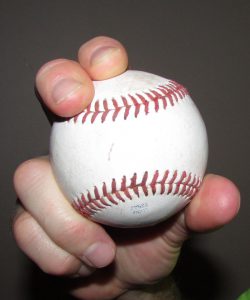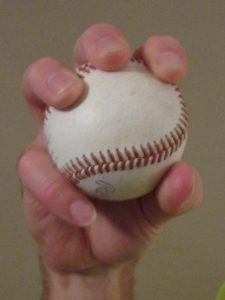Hey everyone and welcome back! Today’s topic: What are the top 5 pitches in baseball?
 First things first: This is not a list compiled of strictly statistical data.
First things first: This is not a list compiled of strictly statistical data.
This is a list of my own opinions on the importance of each pitch, with a brief description of what each pitch does and why I believe it is important.
While everyone will have their own opinion on what pitches are the best, I wanted to share with you my own top 5 pitches that will give any pitcher who can master them a big advantage over most hitters.
With that out of the way, lets get started.
What Are The Top 5 Pitches In Baseball?: The 4-Seam Fastball
I will start things off with the 4 seam fastball: The four seamer tops the list for me simply because it is the
easiest pitch to control.

The main purpose of the 4 seamer is velocity (speed). It features little to no movement, meaning that it doesn’t break or curve.
It is thrown to challenge the hitter, to see if you can throw it by them before they can hit it.It is also the main pitch a pitcher would throw when they need to throw a strike.
Major league pitchers often approach, or even surpass the 100 mph threshold, which as you can imagine makes it one of the hardest pitches to hit too. If you are teaching a young kid to pitch, this is the one you would want to start with.
Top 5 Pitches In Baseball: The 2-Seam Fastball

On to the 2 seam fastball: The 2 seamer is thrown almost identical to the 4 seamer, except now we will add some movement to the pitch. Although you will lose a couple of mph, it is well worth the trade off with the movement you will be able to create.
The regular grip will generally cause the ball to dip down and trail back towards the pitchers throwing hand as it approaches the plate. Minor adjustments to the grip, such as adding a little more pressure to one or more fingers, can make the ball dive or tail more dramatically.
It is definitely a little harder to control, but with some practice I think you can see the benefits of mastering the 2 seamer.
Top 5 Pitches In Baseball: The Curveball/Slider
Next up is the curveball: I like to think of the curveball as the equalizer for the pitcher. Its main purpose is to fool the batter into thinking the ball will be in one place, only to have it dive or break drastically as it reaches the plate.
A typical curveball will generally start high and dive in a downward motion as it approaches the plate. A good

pitcher who has mastered the curveball can actually throw the ball directly at the batter, and have it break back over the plate at the last second.
Imagine seeing the ball coming directly at you after you just tried to hit a 100 mph fastball….This is where we get the term “kneebuckler” as the batters knees buckle under them as they desperately try to avoid being hit by the pitch.
And now my personal favorite. The slider: The slider is best described as a mix between a curveball and a fastball. Velocity on the pitch will generally be between 5-10 mph slower than a fastball, and 10-20 mph faster than a curveball.
Thrown correctly, the slider will have a much sharper break, with little diving action until the last second when the ball approaches the plate. To a batter, the slider will look like a fastball coming in for a strike, only to dive and break out of the strike zone.
Although the slider can be thrown with any count on the batter, to me it is simply the best strike out pitch in baseball. The curveball and slider have almost identical grips. Throwing the curve with the same hand and arm action as a fast ball will give you the slider movement.
Top 5 Pitches In Baseball: The Changeup
Last but not least. The changeup: The main purpose of the changeup is to disrupt the timing of the batter. In

other words, you are trying to get the batter to swing too early.
The changeup is thrown with the same arm action as the fastball, with a different grip. When the batter sees the ball released from the pitchers hand it will look like a fastball. Since the batter won’t be able to detect the slower speed until the last 20-30 feet before the ball reaches the plate, it is usually too late to make the adjustment.
Slight adjustments to finger pressure and grip can add some movement to the pitch too. As you can see, the changeup can be a valuable pitch that I would encourage all pitchers to add to their arsenal.
What Are The Top 5 Pitches In Baseball?: Wrap It Up!
Learning to throw all of these pitches can be quite a challenge. I have spent countless hours with my kids trying to teach them each one and I have enjoyed every minute.
If I were to recommend 2 pitches that every pitcher needs to master, it would be the 4 seam fastball and the changeup. Using these 2 pitches together will keep hitters guessing.
For kids, these are the only 2 pitches that I would teach them. I always say to “Don’t teach them to throw a curve til they need to shave.” Making slight grip adjustments to the change up should produce all the movement they need on a pitch.
Types of Baseball Pitches
- Backdoor Slider
- Changeup (CH)
- Circle Changeup
- Curveball (CU)
- Cutter (FC)
- Eephus (EP)
- Forkball (FO)
- Four-Seam Fastball (FA)
- Knuckleball (KN)
- Knuckle-curve (KC)
- Palmball
- Screwball (SC)
- Sinker (SI)
- Slider (SL)
- Slurve
- Spitball
- Splitter (FS)
- Two-Seam Fastball (FT)
Want a pitching machine that throws all these pitches, without breaking the bank?
Check out our #1 recommended pitching machine!
I hope you enjoyed the article. If you have any questions about a particular pitch, or anything else that I can help you with, please leave a comment below and I will get back with you A.S.A.P.
If you have your own top 5 pitches in baseball, we would love to hear from you. 🙂
Thanks for stopping by ~Jeremy

good stuff dude
Thank you!
I’m glad you enjoyed the article on my top 5 pitches in baseball.
Thanks for stopping by ~Jeremy
Good pitch descriptions! I like the slider, too, but my fave was always a good curveball.
Hi Carla.. It’s hard to argue with a good curveball!! Thanks for the comment, and hope to see you soon. ~Jeremy
Hi Jeremy. I didn’t know there were different ways of pitches. I have always thought it is just 1 way of holding the ball and different way of throwing it. Nice informative post and a new thing learnt for me! Thanks and good job!
Thanks Jay! There are so many different ways to throw every pitch. You could literally say there are thousands of unique ways each pitcher can use to make each one do what they want. Thanks again for stopping by. ~Jeremy
Thanks for this article. I am not a big fan of baseball, but my son wants to play little league and this helps me be able to give him some advice on the different kinds of pitches to expect when at the bat. I was not aware of all of the technique that a pitcher uses when throwing the ball. It makes me appreciate what they do a lot more.
Hi Josh. It is amazing how so many little changes in technique can alter the movement on the ball. I’m sure your son is going to love the game. If you or your son ever have any questions, or just want a little advice, don’t hesitate to check in and I will get back with you a.s.a.p. ~Jeremy
Jeremy this is a great post! Being a big baseball fan, I agree with your choice of pitches, but I’m not sure about the order. I think it depends on the pitcher and what he’s comfortable with. All things being equal, I guess I would go 4 seam, 2 seam, slider, curve/changeup (either or). Great job!
Hey Tom. I’m glad you enjoyed the article. All pitchers seem to have their own choice of favorite pitches, but like you said, it depends on what the pitcher is comfortable with. The 4 seamer seems to top a lot of lists. Thanks for the comment and hope to see you again soon. ~Jeremy